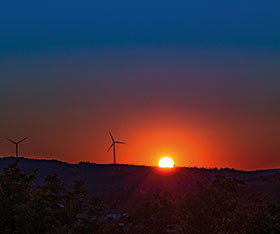

It goes without saying that South Africa’s capacity for solar power generation is enormous, and is a very long way from being fully tapped. When it comes to wind power, it has long been recognised that there is potential, but the question of just how much potential has been ‘up in the air.’
A new study by the Council for Scientific and Industrial Research (CSIR) reveals that South Africa’s potential to produce electricity from wind turbines is significantly greater and much more widely spread than initially thought. The joint research study, conducted by the CSIR in collaboration with the South African Energy Development Institute (SANEDI), Eskom and the Fraunhofer Institute for Wind Energy and Energy Systems (IWES) in Kassel, Germany, reveals that South Africa has an abundance of both wind and solar resources.
“The overarching objective of this study was to increase the fact base and the understanding of aggregated wind and solar photovoltaic (PV) profiles in South Africa for different spatial distributions of a hypothetical wind and solar PV fleet,” says Dr. Tobias Bischof-Niemz, head of CSIR’s Energy Centre.
“The study outputs can serve as input into South African energy-planning processes such as the Integrated Energy Plan (IEP), the Integrated Resource Plan (IRP) for electricity, strategic grid planning, the Transmission Development Plan (TDP), wind and solar PV Strategic Environmental Assessments (SEAs).” Conducted over 11 months from May 2015 to March 2016, the study provides a quantified fact base that will allow higher acceptable penetration levels of wind and solar PV into the South African power system.
Individual solar PV and wind farms exhibit strong short-term (intra-hour) variability. However, the portfolio effect of aggregating the power output of several farms spread over a wide area leads to disappearance of intermittency and short-term fluctuations. The aggregated wind portfolio power output exhibits intra-day variability with changes over several hours. This level of variability is more manageable from a system operator’s point of view.
“The magnitude and cost competiveness of wind power in South Africa is on par with that of solar PV. In addition, wind and solar PV are complementary, with wind supply peaking in the evening and solar PV peaking at midday,” says Crescent Mushwana, research group leader at the CSIR’s Energy Centre.
Renewable Energy Development Zones (REDZs) for wind and solar PV selected by the Department of Environmental Affairs are a good starting point. When expanding the REDZ further, the study shows that the wind resource should not be the limiting factor in the selection of these zones, but the focus should be mostly on environmental considerations.
The same applies for long-term grid planning: The wind resource is excellent in such wide areas that it should be further investigated, whether to build wind farms only in areas where the grid already exists or where it will exist in the near future.
The total technical wind power potential in South Africa if wind farms were to be installed all across the country, except in exclusion areas (national parks, settlement areas, etc) is 6700 GW, which is a wind fleet large enough to supply the entire world’s electricity demand. In order to generate 250 TWh/yr, which is approximately today’s South African electricity demand, 0,6% of the available South African land mass would have to be dedicated for wind farms with an installed capacity of approximately 75 GW.
The primary findings of the study include the following:
• More than 80% of South Africa’s land mass has enough wind resource for economic wind farms with very high annual load factors of greater than 30%.
• The vast size of the South African power system allows for a very strong portfolio effect. Short-term fluctuations in the aggregated wind power feed-in are significantly reduced by wide spatial distribution. Where an individual wind farm’s power output can fluctuate by ±90% of its installed capacity within 15 minutes, a widespread wind fleet’s 15-minute fluctuations are reduced to ±4% of installed capacity.
• A share of 50% wind energy in South Africa’s electricity supply does not increase the short-term (intra-hour) gradients if the wind fleet is widely distributed, hence no negative impact on reserve requirements.
• Up to a 65% energy share in electricity supply from a combined wind and solar PV fleet can be achieved without any significant excess energy.
• South Africa exhibits low seasonality in both wind and solar PV supply, which makes the integration easier, because no seasonal storage is required to balance fluctuations.
For more information contact Tendani Tsedu, CSIR, +27 (0)12 841 3417, [email protected], www.csir.co.za

© Technews Publishing (Pty) Ltd | All Rights Reserved